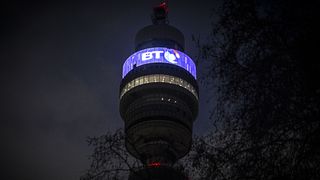BT trials hollow core fibre that could boost 5G
Hollow core fibre could reduce latency across 5G networks

BT is conducting trials of a new type of fibre cable that could improve the economics of mobile network construction and result in better quality 5G services for consumers and businesses.
Fibre networks are currently powered single-mode optical fibre cables that use solid strands of glass to channel light from laser transmitters over long distances. Although fibre cables do this remarkably quickly, the nature of glass means the light travels slower in fibre than it would in air.
Hollow core fibre hopes to reduce this speed by up to 50%. An outer ring of glass guides the light trough a hollow, air filled centre at very close to the ultimate speed of light.
- These are the best business SIM-only deals around today
- And the best business broadband deals
- Here are the best business mobile phone deals
UK 5G rollout
For this trial, a 10km hollow cable developed by Lumenisity, a company that spun out of the University of Southampton, at BT’s Adastral Park R&D facility to see how the technology could aid network development.
“This new type of fibre cable could play an important role in the future of the world’s communications infrastructure, heralding a step-change in capability and speed, to keep up with the demands for high-speed, low latency communications driven by 5G networks, streaming, and more,” declared Professor Andrew Lord, BT’s Head of Optical Network Research.
One potential use case has already been identified. BT and OpenRAN developer Mavenir believe the lower latency of hollow core fibre can increase the distance between mobile antennas and back-end processing in exchanges. This means mobile operators could power more 5G sites from a single exchange or cabinet, improving coverage and capacity at a much lower cost.
“The ability to extend the reach of fibre connected radios only further demonstrates the power of OpenRAN and its Eco System,” added John Baker, Mavenir’s Senior Vice President Business Development. “This improvement will significantly increase the number of use cases that can be served from containerised cloud based OpenRAN.”
Are you a pro? Subscribe to our newsletter
Sign up to the TechRadar Pro newsletter to get all the top news, opinion, features and guidance your business needs to succeed!
OpenRAN is a vendor-neutral approach to radio access network (RAN) technology with standardised designs that allow a variety of firms to supply hardware and software. Operators benefit from increased innovation from a wider range of suppliers, reduced costs and greater flexibility because the threat of vendor lock-in is reduced.
- Here are the best broadband deals around today
Steve McCaskill is TechRadar Pro's resident mobile industry expert, covering all aspects of the UK and global news, from operators to service providers and everything in between. He is a former editor of Silicon UK and journalist with over a decade's experience in the technology industry, writing about technology, in particular, telecoms, mobile and sports tech, sports, video games and media.
Most Popular


